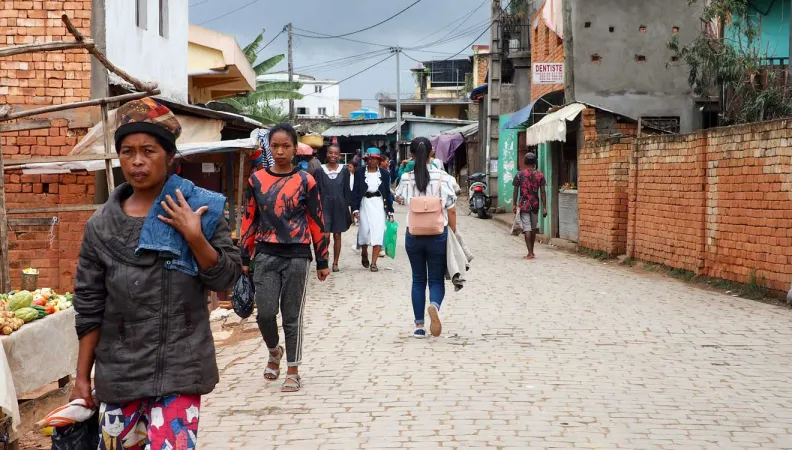Share the page
AFD in Madagascar: Reversing unsustainable urban development
Published on

In Madagascar, unchecked urban growth has generated a host of social problems, from sub-standard housing to inadequate sanitation systems. But three programs funded by AFD are providing real results, making cities more sustainable, and improving living conditions. We take a closer look.
In just over two decades, city populations in Madagascar have almost tripled from 2.8 million in 1993, to some 7 million in 2018. Such rapid growth has taken place across the continent, unleashing a host of social and environmental challenges. That’s why the United Nations made sustainable cities and communities one of the 17 Sustainable Development Goals (SDGs), to cope with runaway global urbanization.
It’s also why Agence Française de Développement made urban development a priority for its work in Madagascar, launching three major projects over the past decade.
Lalankely: Making the environment safe to live and work
Antananarivo’s population has soared to more than 2.5 million, with unsustainable urbanization hitting the poor hardest. About 70% of new housing in the capital is inadequate - and located in flood-prone areas.
Gilbert Fanahisoa, 38, remembers growing up with his feet often soaked from wading in water: “When we got home late in the evening, the streets were slippery. Sometimes, when we were playing around, we would fall into the canal or the mud.” Today, the streets are dry in this housing area, where Fanahisoa is now a safety manager.
Under the Lalankely program launched in 2011, a number of repairs and small-scale operations were set in motion to clean up the area and meet the needs of the most vulnerable. “It’s an innovative approach”, says Lydia Razafindrahona, head of urban development at AFD. “The Lalankely program allocates a substantial amount of financing to a myriad of small projects.” Having executed 730 operations, the project continues today.
Planned in close consultation with local residents, such projects target poor housing areas, developing streets and alleyways, health facilities, standpipes and washhouses.
“I can work better since the washhouse has been made safe and had a roof fitted,” says Thérèse Ravaoharimanana, who has been working here for 15 years. “As life has become more pleasant in the neighborhoods, we have more customers – and income!”
The initial work done, residents are then assisted with ongoing maintenance. “The arrival of sanitary facilities with showers and public toilets has made residents cleaner and less sick,” says Sofa Rakotomanana, Vice-President of the 3rd District. “The maintenance of the facilities is then handled by local associations, which works well.”
PIAA: Tackling flooding and stagnant water
But there is still work to be done. “Despite all the construction, the water hasn’t been drained from the slums in the capital,” says AFD’s Lydia Razafindrahona. In a country where water-borne diseases are the second cause of mortality, drainage and sanitation remain critical issues.
Launched in 2016, the Integrated Sanitation Program in Antananarivo (PIAA) aims to control flooding in the capital’s slums, which were built on former paddy fields. In a drive to make urban planning more sustainable, investments were aimed at improving sanitation systems and communication on hygiene issues.
In the field, daily management for water and sanitation management is entrusted to RF2 – “Rafitra Fikojàna ny Rano sy Fidiovana” in Malagasy – or associations composed of users and neighborhood representatives.
“Collecting funds from residents, they handle maintenance in the sanitation sector,” says Solo Razafinjato, technical coordinator for the NGO Care, which works with RF2. “This involves managing the entire waste cycle: the sorting, transport and recovery of household waste.”
PADEVE: Improving living conditions in secondary cities
However, population growth puts pressure on the entire country, including secondary cities of between 150,000 and 300,000, which have high rates of growth. “They have an administrative, social and economic mission to open up surrounding areas,” says Felana Olisoa, Director of Sustainable Urban Development at the Ministry of Spatial Planning and Public Works.
This is what prompted AFD to launch the Support Program for Balanced City Development in Madagascar (PADEVE), in Antsirabe, Antsiranana, Fianarantsoa, Mahajanga, Toamasina and Toliara. “Secondary cities face the same issues as the city of Antananarivo: lack of infrastructure and facilities such as for water, electricity, roads and sanitation, as well as the proliferation of slums and vulnerability to environmental disasters,” says Felana Olisoa.
In addition to building infrastructure, the program helped municipalities address governance issues that have arisen with decentralization.
Here too, the “Lalankely” approach prevails: activities are carried out with close consultation with the most deprived people affected, an approach recently commended by the Minister of Spatial Planning, Hajo Andrianainarivelo: “People want to be able to feel the effects of these actions in their daily lives. For once, they can see the result as soon as they leave their homes.”
